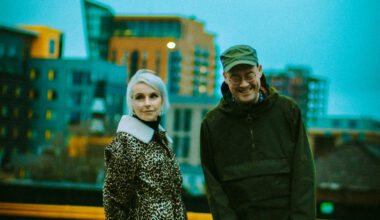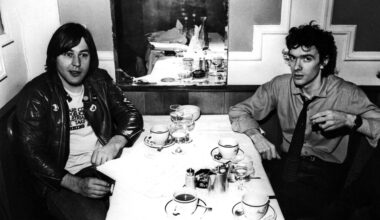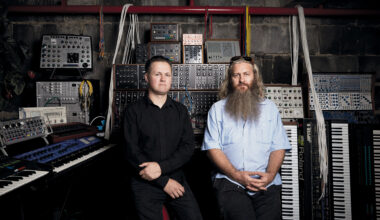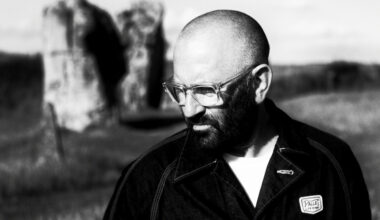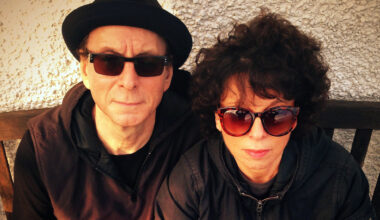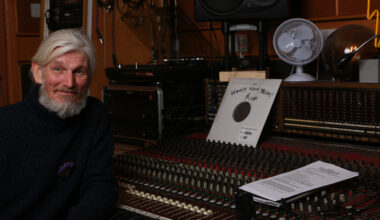Vintage gear is at the heart of the Gearbox Records operation that provides high quality vinyl releases with every step undertaken in-house. Meet the London-based label with a difference…
“Back in the old days,” begins Gearbox Records’ big chief, Darrel Sheinman, “a label would do everything from start to finish, from recording to pressing, and that’s the dream here. If you control each part of the process you produce a better product. Period.”
We’re at Gearbox’s small but perfectly formed studio in one of the many developments springing up on what used to be pretty much a wasteland behind London’s Kings Cross station. Not far from here, is the new Central Saint Martins art school, round the corner is Spiritland and everywhere you look there’s workers in hi-vis vests, huge cranes and new buildings springing up everywhere.
The studio itself is a complete mastering suite in a space no bigger than average front room. Better still, there’s a line-in from the next door, Mark Ronson’s studio no less, for when more space might be required. As you enter Gearbox, it’s the very distinctive smell of old, warm valves that greets you. And no wonder, it’s wall-to-wall with vintage kit. But this is no museum…
“One of the reasons we’re into vintage equipment isn’t because it’s retro,” says Darrel. “These machines were built to be the best they could be. They were way ahead of their time and they’re still better than anything you can buy new these days.”
Along the back wall sits a Scully cutting lathe, an almighty looking beast used to cut lacquer masters for the pressing plant. Along the far wall there’s the monitoring gear, record decks, amps and speakers. Down another wall there’s two old Studers, reel-to-reel tape machines of legend. Every studio worth their salt had Studers back in the day. That they have a pair of them here says much about Darrel and what Gearbox are striving for.
He’s an interesting chap is Darrel. A huge music fan at heart, he’d already lived several lives before he arrived in King’s Cross with a dream of his very own specialist production house.
“I was on the stock exchange floor with all the screaming and shouting for many years,” he says, when one day, out of the blue, he had an idea to track ships by satellite.“A mate of mine used to export red telephone boxes to California and he lost a cargo. I said, ‘That’s ridiculous, surely we can track ships?’, but no you couldn’t.”
So in 1997 he left the world of stocks and shares and set up Pole Star who were first out of the blocks when it came to tracking shipping, online, in real time. Following the tragic events of 9/11, all ships were required to be tracked and Pole Star were the only company in the world able to do it. Stepping down from running the company in 2005, and during a spell as a private security consultant alongside ex-Special Forces “doing reccies and advising people on safety in dodgy parts of the world”, Darrel started Gearbox Records, just as a hobby mind, in 2009.
“I thought, ‘I love jazz, I’ll look at releasing stuff that’s never been out on vinyl before’,” he says of the new venture. “So I’d go to the British Library and for research, looking for old broadcasts, sessions. The first release was Tubby Hayes, a British sax player from the 60s who’s got a real cult following, and we did another sax player, Joe Harriott, and both releases sold out. It took a while, maybe a year, but it’s simple when it’s a hobby. It’s a bit like the house you live in. If you’ve bought a house it makes money, it’s easy, but you can’t sell it because you live in it. If you then become a property developer, you’ve got the problems of tenants, the margins are tight, no one will lend you money for a second property…”
But after 10 releases on the label, Darrel took the plunge and Gearbox moved from a hobby to a full-time concern in 2102.
“We built this studio with an acoustic engineer, it was a carpet sales place before, it was horrible, really grubby,” he says. “It’s a floating room so the floor sits on rubber supports with sand underneath, there’s a studio upstairs too, which is the same so the room is totally isolated. It’s also on its own ring main so we don’t get any electrical interference.”

You’re thinking what we’re thinking. How on earth do you know you need all his stuff in the first place?
“I’ve always been into kit,” says Darrel, “but when you’re working with sound engineers all the time you begin to understand what you need to get the best possible signal path. And that means the best reel-to-reel tape machines straight through an all-analogue chain to a great cutting machine.”
So no digital in the chain then?
“We do have digital because we’re a commercial studio and we can master digitally,” he says. “The underlying philosophy of Gearbox is that music is a snapshot in time. The Stones would spend months in the studio, not recording, but developing ideas so the when they were recording it was the perfect snapshot. A lot of music is over-produced, it’s not real. People are really struggling to communicate with their audience, because they can’t play live what they’ve put on the record. We’d like to see more people just getting back to this whole idea of creating music and that’s why we’re here.”
In among all this chat we’ve barely mentioned the label at all. While they started out as a jazz imprint, they’re beginning to hit their stride and are spreading their wings into contemporary folk and also, luckily for us, electronica. They’ve a couple of projects lined up later this year that we will no doubt be visiting on these pages, including a release by Max Cooper that involves capturing sounds from sculptor Anthony Gormley’s studio and a singles club that promises not only a seven-inch single each month, but a rather clever turntable Gearbox themselves have been developing to play the records on. And all this is only the tip of the Gearbox iceburg. Watch this space.
Darrel Sheinman’s guided tour to the analogue delights in the gearbox records studio
Haeco Scully Lathe
“Peter Qvortrup, the owner of Audio Note, who are one of the top hi-fi manufacturers in the world, is a collector and he had this lathe in a storage area underneath one of his offices. It took a year to restore and cost £20,000, but we split the bill and I lease it off him monthly. Who restores cutting lathes? There’s a famous guy called Sean Davies, he’s in his eighties, he used be at Decca and he is the main guy for lathes. He taught me how to master. Who better to teach you than the legend Sean Davies? Jerry Cooper, another mastering engineer, used to run the studio for our sessions and I learned a lot off him as well. So that’s where I learned to cut and master… sounds like a hairdresser. Because we have this lathe here I don’t have to be in a queue for mastering, we can do all the quality control right up to the pressing plant right here. If we need to do a re-cut, I don’t have to argue with the mastering house, we just get on with it.”
Western Electric Cutting Amps
“The rack that houses the cutting amps came from a state-owned record label in Colombia, then it came to a company in east London. They went bust, and it ended up with Peter Qvortrup in his collection and then it came here with the lathe. The cutting amps are used to send the signal into the cutting head. All the interesting looking dials, switches and buttons are EQs, limiters and other amp circuitry.”
Gearbox Lab Coats
“Ideally you should have an anti-static room when you’re cutting vinyl, because the compound you cut into is easily charged with static so dust is attracted straight to it and obviously that can ruin your cut. We wear the anti-static lab coats, which are laced with metal so they discharge the static. It’s suggested you put a bucket of water in the corner and that takes the static out of the room. You are supposed to wear anti-static boots too, but they’re not very cool so we don’t wear them. There aren’t many studios that stick to this stuff, a lot of people think we’re nerds and it’s irrelevant, but I think all of these little details are actually what makes the music sound better.”
Monitoring By Audio Note
“Audio Note no longer have a studio in London so Peter has lent us some monitoring equipment, there’s a £37,000 amplifier, a £10,000 pre-amp, which we can’t afford, but he lets us use them because then he can bring people in and showcase his equipment here…and we can say on every release that the monitoring is by Audio Note. Everything goes through their amps for final listening, it helps that they’re fabulous looking too. The speakers are Audio Note as well, they’ve got hemp cones, unfortunately they take 500 hours to break in, but once they’re broken in they’re fantastic.”
Studer C37
“The 1965 C37 is our workhorse. It’s probably the most iconic tape machine ever made, the combination of valve amps and tape sounds delicious. It’s all valve, modular [flips the lid like a car bonnet so we can peer inside] so each of the components you can pull out and replace if they fail. It’s beautifully designed. They have a light bulb to complete the circuit when you’re in record mode, it blows if something goes wrong like a fuse… and of course you just change it.
Look at the build quality, the stability of the machinery. This was made when recording music was a research lab art. They were way ahead of their time.”
Studer H37
“There were only 12 of these made, it’s a half-inch machine with an interchangeable three or four track head block. There’s a lot of recordings on half-inch three track, but there are very few machines left that can play them, many of the half-inch machines were converted to two channel stereo.
“I bought this off a guy in Switzerland called Andreas Kuhn, who services and repairs Studers. His dad used to work for Studer, he has Swiss precision in his blood. According to him, there’s a working H37 in the Studer museum and this was the only other working one. Andreas also looks after the Studers at Abbey Road. They’ve got a J37, which is the next machine up, the one-inch machine. There’s a conversion kit that Studer built to change a J37 into a half-inch configuration in which case they could play all their old three track tapes… the trouble is the kits are rarer than the machines because they were used for spares. Are they aware that we have a working three-track machine? I have spoken to them and said we’ve got this machine and I remember their studio manager told me, ‘Oh yeah, we’ve got all that too. And I was thinking, ‘No you don’t!’.”
Decks
“We have an ex-BBC EMT deck. When Bush House closed they sold off a lot of their gear and this is one of their turntables. EMT turntables are the best in the world. This is a great machine, it goes backwards as well, so you can queue things up very easily. We can also use it for mastering off 78, it got an XLR out so we can plug it straight into the studio. It’s a real workshorse, we use it as our reference turntable, it even fits 14-inch lacquers so we can playback test cuts on here. It’s an amazing machine, we got it for a couple of grand from the auction at Bush House and they go for about eight so that was quite a lucky buy.”

